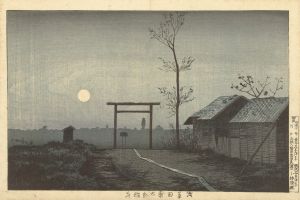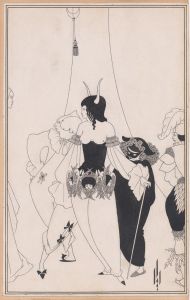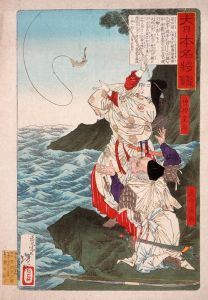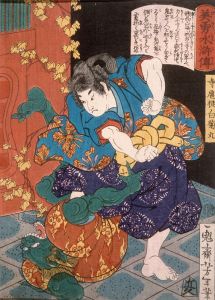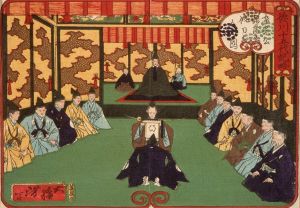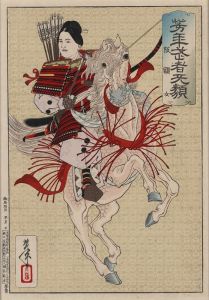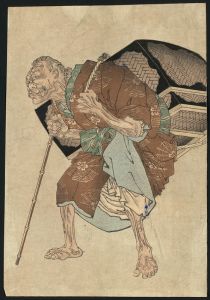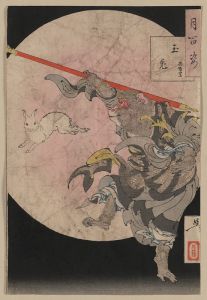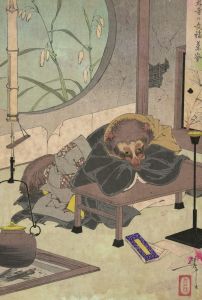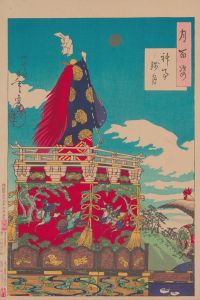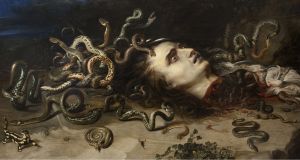
The Priest Daijin Murders Umegae
A hand-painted replica of Tsukioka Yoshitoshi’s masterpiece The Priest Daijin Murders Umegae, meticulously crafted by professional artists to capture the true essence of the original. Each piece is created with museum-quality canvas and rare mineral pigments, carefully painted by experienced artists with delicate brushstrokes and rich, layered colors to perfectly recreate the texture of the original artwork. Unlike machine-printed reproductions, this hand-painted version brings the painting to life, infused with the artist’s emotions and skill in every stroke. Whether for personal collection or home decoration, it instantly elevates the artistic atmosphere of any space.
"The Priest Daijin Murders Umegae" is a woodblock print by the renowned Japanese artist Tsukioka Yoshitoshi, who is celebrated for his innovative and dramatic approach to ukiyo-e, a genre of Japanese art that flourished from the 17th through 19th centuries. Yoshitoshi is often regarded as the last great master of this traditional form, and his works are noted for their dynamic compositions and psychological depth.
This particular print is part of Yoshitoshi's series "New Forms of Thirty-Six Ghosts" (Shinkei Sanjūrokkaisen), which was published between 1889 and 1892. The series is a collection of supernatural and ghostly tales, each depicted with Yoshitoshi's characteristic flair for the dramatic and the macabre. The series reflects the Meiji period's fascination with the supernatural and the blending of traditional Japanese themes with Western influences.
"The Priest Daijin Murders Umegae" illustrates a scene from a Japanese legend or folklore, a common source of inspiration for Yoshitoshi's ghost series. In this print, Yoshitoshi captures a moment of intense drama and emotion, showcasing his skill in portraying complex narratives through visual art. The composition likely features the titular characters, the priest Daijin and Umegae, in a moment of confrontation or violence, as suggested by the title. Yoshitoshi's use of color, line, and expression would have been employed to heighten the tension and convey the supernatural elements of the story.
Yoshitoshi's work is characterized by its attention to detail and its ability to convey the psychological states of its subjects. His prints often explore themes of conflict, transformation, and the boundary between the human and the supernatural. In "The Priest Daijin Murders Umegae," these themes are likely present, as the title suggests a narrative involving betrayal, violence, or revenge.
The "New Forms of Thirty-Six Ghosts" series, including this print, is significant not only for its artistic merit but also for its cultural and historical context. During the Meiji era, Japan was undergoing rapid modernization and Westernization, and there was a growing interest in preserving traditional Japanese culture and folklore. Yoshitoshi's work can be seen as part of this broader cultural movement, as he sought to capture and reinterpret traditional stories for a contemporary audience.
Yoshitoshi's prints, including "The Priest Daijin Murders Umegae," are highly regarded for their technical excellence and their ability to evoke emotion and intrigue. They remain popular among collectors and are studied for their insights into both the art of ukiyo-e and the cultural history of Japan during a time of significant change.
Overall, "The Priest Daijin Murders Umegae" exemplifies Yoshitoshi's mastery of the woodblock print medium and his unique ability to blend traditional Japanese themes with a modern sensibility, creating works that continue to resonate with audiences today.






